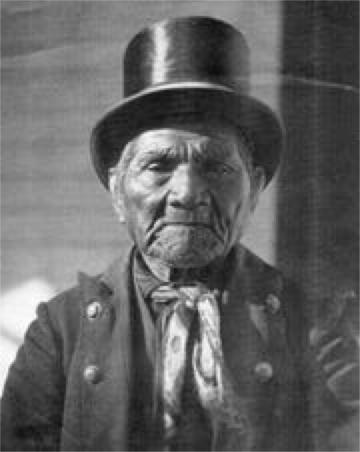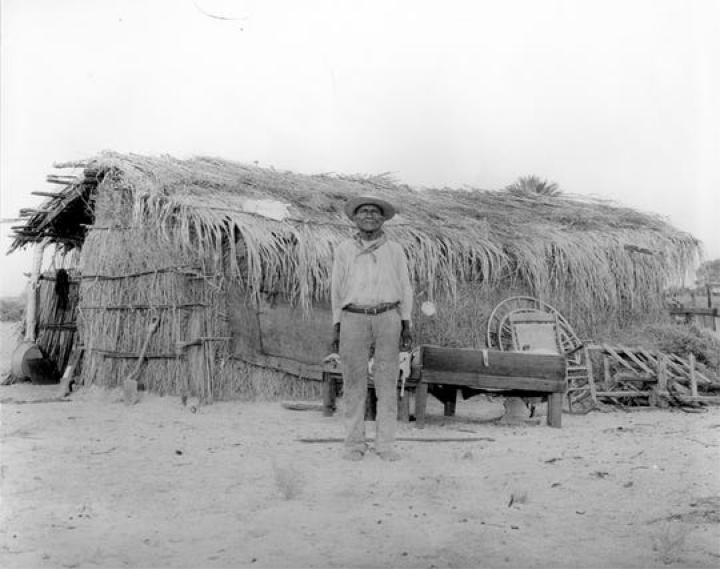 |
Canku Ota
|
 |
|
(Many Paths)
|
||
|
An Online Newsletter
Celebrating Native America
|
||
|
July 2020 - Volume 18
Number 7
|
||
|
|
||
|
Fig Tree John Of
Torres Martinez Tribe, A Real — And Fictionalized — Legend
|
||
|
by Tracy Conrad, Special
to The Desert Sun
|
||
In his 1971 introduction to the re-printing of the 1934 book, New York University English Professor Walter James Miller observed, “Fig Tree John is not only one of our greatest novels about the predicament of the American Indian, it is also one of the best studies of the white man’s weaknesses as perceived by the red man. Hence Edwin Corle’s little classic is far more ‘relevant’ for us today than when it first appeared in the 1930s. For now the white man, somewhat humbled by his own follies, is almost willing to learn something from other ways of life, almost ready to see himself as the ‘ofay-watchers’ have always seen him.” The book is again relevant today, as it was in 1971 and when it first appeared in the middle of the Great Depression, and its introduction is also strangely resonant. The introduction, as all introductions do, heaps praise on the novel, particularly noting its sensitive exploration of clashing traditions. It ends with the admonishment that, “Portraying both cultures at their best and their worst, Corle makes no judgements at all…(but) simply makes us regret that these two great peoples never meshed their talents while both of them were still in their prime.” The book, its author and its namesake subject are a fascinating page in the history of the multiple cultures of the Coachella Valley. The real-life person, Fig Tree John, known also by his Spanish name, Juanito Razon, was credited with planting the first fig tree in the Coachella Valley and cultivating more. He was a member of the Torres Martinez Band of Cahuilla Indians. Fig Tree John was said to walk barefoot through the hot desert sand. He was known to wear a silk top hat and a military coat. His haunting and elegant image makes it easy to understand why he inspired the young short-story writer Edwin Corle to pen an entire book. Corle was a boy when he saw the Salton Sea and the Arizona and California deserts for the first time. Corle’s imagination was captured: “There he heard Mexicans, Indians, and whites tell their fascinating tales.” He would embellish scores of these stories and imbue them with authentic character earning the admiration of avid readers and bibliophiles like the erudite Lawrence Clark Powell, Librarian at UCLA.
Corle was born in New Jersey in 1906 and as a youngster traveled through the Southern Californian deserts. He was educated at the University of California, Berkeley, earning his undergraduate degree in 1928. For two years he was a graduate student at Yale University. He contributed non-fiction articles and short stories to the Atlantic Monthly, Harpers, The New Yorker and Scribner’s. Corle died just one month past his 50th birthday in 1956, having a tragically abbreviated, but productive, life. His descendants are still here in the desert. "Fig Tree John" was written when Corle was only 28 years old and is arguably his masterpiece. Corle fictionalized the life of the peaceful Cahuilla Indian, making John a renegade Apache with a violent grudge against all whites. When the novel was first published in the middle of the 1930s, those who remembered the real-life man were upset. Fig Tree John was already the stuff of mythology early in the 20th century when The Los Angeles Times noted, “Fig Tree John is a striking character…He is said to be 102 years old and he bears the scars of fifty battles…He is dressed in his customary uniform of army blue, brass buttons and all, high stovepipe hat with red band.” The Times recounts how John proved himself a hero by rescuing the sons of Ulysses Grant, Jr., who had set out from San Diego for Colorado when “their machine broke down while bucking the sand.” The Grants were without water and would have perished without the kindness of the Cahuilla Indian. The legend of Fig Tree John is now mostly remembered by the story that Thomas L. “Pegleg” Smith, another colorful desert character, who, when close to death, confided the whereabouts of his hidden gold mine to Fig Tree John, the trustworthy Cahuilla, who kept the secret safe (the search for the lost gold mine is another fascinating story for another day). Unlike the fictionalized character, Fig Tree John meshed the best talents from the cultures around him, embodying them all. He was witness to their clash. The last report of him in The Los Angeles Times on Sept. 10, 1926, remarked, “A single link connected Riverside’s pioneer past with its modern present day when a monument to Louis Rubidoux and General Fremont, the first colonizers of this section, was unveiled at the site of the old American fort here. That link was Juan Razon, better known as Fig Tree John, 130 years of age, who eighty years ago served General Fremont as a scout during the Mexican war. Whether Fig Tree John, a Mission Indian, is really 130 years of age or not is impossible of substantiation…" “Garbed in an old blue uniform of the Union army, Fig Tree John stood out among the throng of Riversiders like a century-old oak growing in a grove of saplings.” In striking contrast to Edwin Corle, Fig Tree John, or Juanito Razon, lived remarkably long. The exact date of his birth is unknown. But, he died on April 11, 1927, on the Cahuilla reservation at Martinez. His son and daughter, Johnnie Mack and Minnie Mack, grew up there, eventually married and moved to the San Jacinto Valley. His son always maintained that Fig Tree John lived to be 136 years old. |
||||
|
|
|
|
||
|
|
||
| Canku Ota is a free Newsletter celebrating Native America, its traditions and accomplishments . We do not provide subscriber or visitor names to anyone. Some articles presented in Canku Ota may contain copyright material. We have received appropriate permissions for republishing any articles. Material appearing here is distributed without profit or monetary gain to those who have expressed an interest. This is in accordance with Title 17 U.S.C. Section 107. | ||
|
Canku Ota is a copyright ©
2000 - 2020 of Vicki Williams Barry and Paul Barry.
|
||
 |
 |
|
|
The "Canku
Ota - A Newsletter Celebrating Native America" web site and
its design is the
|
||
|
Copyright ©
1999 - 2020 of Paul C. Barry.
|
||
|
All Rights Reserved.
|
||

